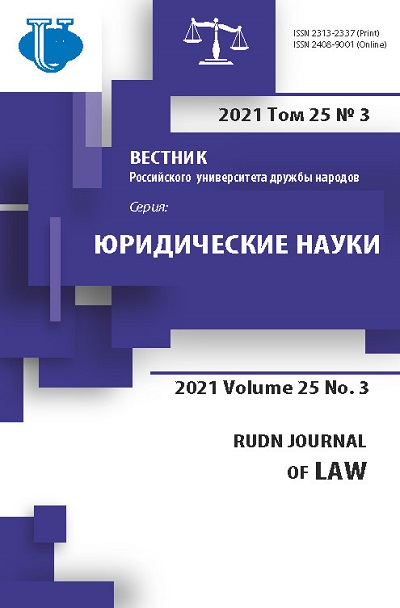Close-out netting in the European Union: contract practice and unification of legal regulation
- Authors: Klementyev A.P.1
-
Affiliations:
- National Research University Higher School of Economics (NRU HSE)
- Issue: Vol 25, No 3 (2021)
- Pages: 634-653
- Section: CIVIL LAW
- URL: https://journals.rudn.ru/law/article/view/27222
- DOI: https://doi.org/10.22363/2313-2337-2021-25-3-634-653
Cite item
Full Text
Abstract
The article focuses on the general characteristics of the European Union legal framework pertaining to close-out netting; it offers analysis of standard documentation provisions used within European Union for netting. Close-out netting is the process of termination of financial transactions by the parties in case of violation of obligations under master agreements, often with participation of banks and other financial institutions. Currently, EU legislation on netting consists of two major parts (regulatory regimes): the prudential regime and the insolvency regime. The former addresses banks and financial institutions regulating requirements for financial ratios and capital adequacy of these organizations. The insolvency framework is the most complex of the said legal regimes as it is comprised of various directives and regulations affecting performance of netting in the course of bankruptcy procedures. In recent years, the insolvency regime has undergone immense change marking the transition from unconditional legislative support of netting without any exemptions to a more balanced approach aimed at limiting close-out netting possibilities with respect to systematically important financial organizations.
About the authors
Aleksey P. Klementyev
National Research University Higher School of Economics (NRU HSE)
Author for correspondence.
Email: aklementiev@hse.ru
ORCID iD: 0000-0002-6598-507X
assistant, School of Legal Regulation of Business, Faculty of Law
20 Myasnitskaya str., Moscow, 101000, Russian FederationReferences
- Benjamin, J. (2007) Financial Law. Oxford, Oxford University Press.
- Benzler, M. (1999) Nettingvereinbarungen im außerbörslichen Derivatehandel (Deutsches, Europäisches und Vergleichendes Wirtschaftsrecht). Baden-Baden, Nomos Verlagsgesellschaft. (in German).
- Bliss, R.R. & Kaufman, G.G. (2006) Derivatives and systemic risk: Netting, collateral, and closeout. Journal of Financial Stability. 2 (1), 55-70.
- Böger, O. (2013) Close-out netting provisions in private international law and international insolvency law (Part I). Uniform Law Review. 18 (2), 23-261. doi: 10.1093/ulr/unt014
- Chun, C. (2012) Cross-border Transactions of Intermediated Securities: A Comparative Analysis in Substantive Law and Private International Law. Berlin, Heidelberg, Springer.
- Cranston, R., Avgouleas, A., van Zwieten, K., Hare, C. & van Sante, T. (2018) Principles of Banking Law. (3 ed.). Oxford, Oxford University Press.
- Erpyleva, N.Y. (2004) International banking law: genesis, nature, fundamental categories and mechanisms of regulation of banking transactions. Diss … Doctor of Legal of sciences. Moscow, Russian Academy of Public Administration under the President of the Russian Federation. (in Russian).
- Erpyleva, N.Y. (2011) Modern currency exchange regulation in Russian banking law. Legislation and Economics. (12), 21-43. (in Russian).
- Fuchs, F. (2013) Close-out Netting, Collateral und systemisches Risiko: Rechtsansätze zur Minderung der Systemgefahr im außerbörslichen Derivatehandel. Berlin, Mohr Siebeck. (in German).
- GuyLaine, Ch. (2009) OTC Derivative Contracts in Bankruptcy: the Lehman Experience. NY Business Law Journal. 13 (1), 14-17
- Johansson, E. (2009) Property Rights in Investment Securities and the Doctrine of Specificity. Berlin - Heidelberg, Springer
- Johnson, V.R. (2015). International Financial Law: The Case against Close-Out Netting. Boston University International Law Journal. 33 (2), 101-125.
- Keijser, T. (ed.) (2014) Transnational Securities Law. Oxford, Oxford University Press.
- Lipovtsev, V.N. (2012) Lex mercatoria and securities market - novelties of legal regulation. Business in Law. (1), 114-117 (in Russian)
- Lipovtsev, V.N. (2014) Conflict of laws regulation in lex mercatoria. International Law and International Organisations. (4), 545-550. (in Russian).
- Lober, K. & Klima, E. (2006) The implementation of Directive 2002/47 on financial collateral arrangements. Journal of International Banking Law and Regulation. 21 (4), 203-212.
- Mantysaari, P. (2010) The Law of Corporate Finance: General Principles and EU Law. T. II: Contracts in General. Berlin, Springer.
- Nassetti, F.C. (1995) Basic elements in the maze of netting. Journal of International Banking Law. 10 (4), 145-148.
- Paech, P. (2014) Close-out netting, insolvency law and conflict-of-laws. Journal of Corporate Law Studies. 14 (2), 419-452.
- Paul, C.R.H. (1995) Netting: a means of limiting credit exposure. Journal of International Banking Law. 10 (3), 93-98.
- Paulus, C. (2015) The Wonderful World of Privileges - The Par Condicio Creditorum vs Closeout-Netting. European Company and Financial Law Review. 11 (4), 479-632. doi: 10.1515/ecfr-2014-0531
- Rusen, G. (2007) Financial Collateral Arrangements. Journal of International Commercial Law and Technology. 2 (4), 250-258.
- Vardi, N. (2011) The Integration of European Financial Markets. London, Routledge.
- Walters, R. (2020) Close out netting provisions: their current value in a time of international uncertainty. International Company and Commercial Law Review. 31 (10), 564-595.
- Werner, P.M. (2012) Close-out netting and the world of derivatives in central and eastern Europe and beyond - ISDA’s perspective. In: Law in Transition. Developing capital markets. London, European Bank for Reconstruction and Development. Pp. 48-55.
- Wessels, B. (1997) Close-out netting in the Netherlands. Journal of International Banking Law. 12 (5), 187-194.
- Yeowart, G & Parsons, R. (2016) Yeowart and Parsons on the Law of Financial Collateral. Elgar Financial Law and Practice series. UK, Shepherd and Wedderburn LLP.
















